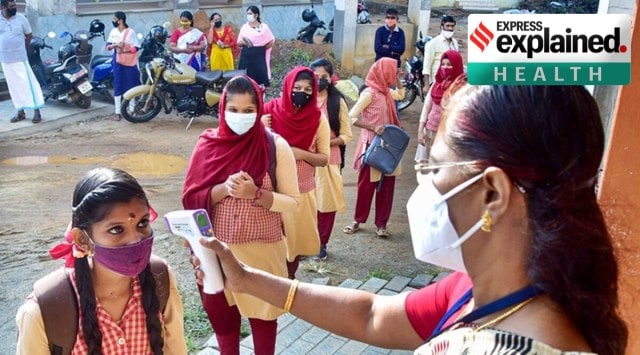- India
- International
Explained: Kerala’s new norms for imposing Covid-19 restrictions
Fourteen districts in the state have been bracketed into three zones - A, B and C - mainly factoring the caseload at hospitals in each district for imposing restrictions. We break down the new guidelines.
 By introducing a new norm for Covid restrictions, Kerala has done away with the prevailing curbs imposed at local levels based on the weekly infection population ratio. (PTI)
By introducing a new norm for Covid restrictions, Kerala has done away with the prevailing curbs imposed at local levels based on the weekly infection population ratio. (PTI)With Kerala’s Covid-19 test positivity rate (TPR) surging to an all-time high of 40 per cent on Thursday (January 21) and active caseload touching 2 lakhs, the state government has introduced a new set of norms for imposing restrictions. This is the third time in the pandemic days that Kerala is experimenting with new norms for curbs.
What are the new norms?
Fourteen districts in the state have been bracketed into three zones – A, B and C – mainly factoring the caseload at hospitals in each district for imposing restrictions. This apart, there would be lockdown-like restriction on next two Sundays, banning all non-essential services. By introducing a new norm for Covid restrictions, Kerala has done away with the prevailing curbs imposed at local levels based on the weekly infection population ratio (WIPR). Business, shopping, tourism, hotel, entertainment, and all means of livelihood would function in compliance with the general Covid-19 protocol and social distancing, except on the next two Sundays. The grading of districts into three categories would be done on every Friday by the district disaster management authority, headed by the district collector.
A zone districts
A Kerala district would be declared as A zone if the rate of admission to hospital in that district doubles from January 1, the baseline date, and the rate of Covid-19 patients admitted to the ICU exceeds 50 per cent. In such A zone district, all cultural, political, religious, public functions, marriages, and posthumous events can be held with participation permitted for 50 persons only. At present, Ernakulam, Alappuzha, and Kollam districts are in A category.
B Zone districts
A district would be declared B zone when more than 10 per cent of the patients admitted to the hospital are Covid-19 patients and if the rate of Covid patients admitted in ICU doubles from January 1. In B zone districts, no cultural, political, religious or other events would be allowed. All religious events and rituals should be held online for the faithful. But marriages and posthumous events would be allowed with 20 persons. At present, Thiruvananthapuram, Palakkad, Idukki, Pathanamthitta and Wayanad would fall in the B category.
C zone districts
In a district if more than 25 percent of the patients admitted to the hospital are Covid-19 patients, that district would be in C zone. No public events, political meetings and religious programmes would be allowed in C zone districts. Theaters, swimming pools and gyms would remain closed in this zone. All classes, except final year graduate, post-graduate programmes, class 10 and 12, would have to be held online in the C category districts. However, residential educational institutions can function on bio-bubble models. As on January 21, no district in Kerala falls into this zone.

Restrictions in districts which do not fit into new zone norms
Of the 14 districts, Kasaragod, Kozhikode, Kannur, Malappuram, Thrissur, and Kottayam do not fit into any of these three zones as per the new norm. In these districts, the hitherto prevailed restrictions based on weekly infection population ration (WIPR), which are virtually nil at ground level, would continue.
What is WIPR?
Since August last year, Kerala had done away with the practice of introducing restrictions, mainly declaring containment zones, at local body level based on test positivity rate in a particular local body. To make life moving and livelihood unaffected, weekly infection population ratio (WIPR) was made the yardstick for restriction. WIPR is the total number of Covid-19 infections reported in the week multiplied by 1,000 divided by total population of the panchayat or urban ward. In panchayats/urban wards with WIPR of more than 10, special intensified stringent lockdown restrictions shall be imposed. This WIPR had reduced the containment zone into those local body wards/divisions, instead closing an entire local body region based on the weekly TPR.
How did WIPR impact restrictions?
The introduction of WIPR had virtually done away with Covid-19 restrictions, such as containment zone, limited to a particular ward in a village panchayat or to a division in a municipal body. This had considerably reduced the number of containment zones in Kerala. For example, when Kerala’s TPR was 37 per cent on January 19, only six wards in five local bodies had containment zone status, that means only these six wards had WIPR above 10 per cent. Not a single local body from Thiruvananthapuram, where TPR was 47 per cent, was not included in the list of wards which have WIPR above 10. WIPR based restrictions were introduced in August last year, after abolishing TPR based restrictions.
Newsletter | Click to get the day’s best explainers in your inbox
What was TPR-based grading of local bodies?
Local self-governing bodies were taken as the unit for implementing restrictions and weekly test positivity rate (TPR) at that particular local body area in a week was taken as the criteria. The number of tests conducted in a local body region and the positive cases fetched from those tests were factored into grading of the local bodies into A, B, C and D categories.
Only those local bodies with less than 5 per cent of TPR were clubbed into A category and those having TPR above 15 per cent were in D category. Normal life was allowed in areas which fall under A category, but the quantum of restrictions went up in B and C categories and completely shut down in D category.
More Explained
EXPRESS OPINION
Apr 26: Latest News
- 01
- 02
- 03
- 04
- 05











































